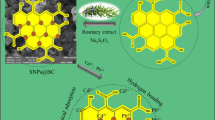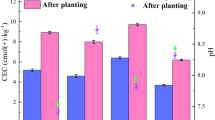Abstract
In China, a large amount of soil lack available silicon, which leads to a decrease in crop yield. Furthermore, the solid waste coal tailings contain abundant minerals that are rich in silicon, which have not been fully utilized. In this work, we used Bacillus mucilaginosus as the leaching agent to convert insoluble silicon in coal tailings into available silicon for crop. After single-factor experiments, the optimal leaching conditions with bacterial dosage, coal tailings weight, initial pH, leaching temperature, and shaking speed were obtained. Kinetic analysis showed that the controlling process of the leaching was a chemical reaction. The leaching process was characterized by X-ray diffraction (XRD), scanning electron microscopy with energy-dispersive spectroscopy (SEM-EDS), Fourier transform infrared spectrometer (FT-IR), and high-performance liquid chromatography (HPLC). The results showed that bioleaching is a feasible and efficient method to extract silicon from coal tailings, with a maximum leaching amount of 260 mg L−1 after 16 days, which occupied 93% of the total effective silicon. In conclusion, this work demonstrates that bioleaching technology can effectively solve the problem of the environmental utilization of coal tailings by converting them into a soil improver that can provide beneficial nutrients for crop growth.
















Similar content being viewed by others
Data availability
The datasets used and analyzed during the current study are available from the corresponding author on reasonable request.
References
Anguiano M, Lopez CE, Luevanos MP, Balagurusamy N (2018) Bioleaching: an innovative biotechnology for recovery of metals from electronic wastes. Chimica oggi: J Chem Technol Biotechnol 36:33–36
Azziz G, Bajsa N, Haghjou T, Taule C, Valverde A, Mariano Igual J, Arias A (2012) Abundance, diversity and prospecting of culturable phosphate solubilizing bacteria on soils under crop-pasture rotations in a no-tillage regime in Uruguay. Appl Soil Ecol 61:320–326
Bhatti HN, Anjum F, Saeed AS (2009) Bioleaching of rock phosphate by Aspergillus niger. Asian J Chem 21(8):6029–6040
Chaerun SK, Sulistyo RS, Minwal WP, Mubarok MZ (2017) Indirect bioleaching of low-grade nickel limonite and saprolite ores using fungal metabolic organic acids generated by Aspergillus niger. Hydrometallurgy 174:29–37
Chen QJ, Xie W, Wei S (2017) Determination of silicon content in Lisong hot spring water by silicon molybdenum blue UV-visible spectrophotometry. Xiandai Huagong/Mod Chem Ind 37:210–214
Ehrlich H, Demadis KD, Pokrovsky OS, Koutsoukos PG (2010) Modern views on desilicification: biosilica and abiotic silica dissolution in natural and artificial environments. Chem Rev 110:4656–4689
Gao L, Wang Y, Huang Q, Guo S (2017) Modes of occurrence and thermal stability of mercury in different samples from Guandi coal preparation plant. Fuel 200:22–30
Gaur S, Kumar J, Kumar D, Chauhan DK, Srivastava PK (2020) Fascinating impact of silicon and silicon transporters in plants: a review. Ecotoxicol Environ Saf 202:110885
Ghosh S, Mohanty S, Akcil A, Sukla LB, Das AP (2016) A greener approach for resource recycling: manganese bioleaching. Chemosphere 154:628–639
Guo Y, Zhao Q, Yan K, Cheng F, Lou HH (2014) Novel process for alumina extraction via the coupling treatment of coal gangue and bauxite red mud. Ind Eng Chem Res 53:4518–4521
Lian B, Prithiviraj B, Souleimanov A, Smith DL (2001) Evidence for the production of chemical compounds analogous to nod factor by the silicate bacterium Bacillus circulans GY92. Microbiol Res 156:289–292
Lian B, Wang B, Mu P, Liu C, Teng HH (2008) Microbial release of potassium from K-bearing minerals by thermophilic fungus Aspergillus fumigatus. Geochim Cosmochim Acta 72:87–98
Liu H, Liu Z (2010) Recycling utilization patterns of coal mining waste in China. Resour Conserv Recycl 54:1331–1340
Liu S, Tang W, Yang F, Meng J, Li X (2017) Influence of biochar application on potassium-solubilizing Bacillus mucilaginosus as potential biofertilizer. Prep Biochem Biotechnol 47(1):32–37
Liu W, Xu X, Wu X, Yang Q, Luo Y, Christie P (2006) Decomposition of silicate minerals by Bacillus mucilaginosus in liquid culture. Environ Geochem Health 28:133–140
Lv Y, Li J, Chen Z, Liu X, Zhang TC (2021) Effects of different silicate minerals on silicon activation by Ochrobactrum sp. T-07-B. Environ Sci Pollut Res:1–9. https://doi.org/10.21203/rs.3.rs-775613/v1
Lv Y, Li J, Ye H, Du D, Li J, Sun P, Ma M, Wen J (2019) Bioleaching behaviors of silicon and metals in electrolytic manganese residue using silicate bacteria. J Clean Prod 228:901–909
Lv Y, Li J, Ye H, Du D, Zhang TC (2020) Bioleaching of silicon in electrolytic manganese residue (EMR) by Paenibacillus mucilaginosus: impact of silicate mineral structures. Chemosphere 256:127043
Mitani-Ueno N, Ma JF (2021) Linking transport system of silicon with its accumulation in different plant species. Soil Science and Plant Nutrition 67:10–17
Monib M, Zahra MK, Abdel El-Al SI, Heggo A (1984) Role of silicate bacteria in releasing K and Si from biotite and orthoclase. Soil Biology & Conservation of the Biosphere
Nyanikova GG, Kuprina EE, Pestova OV, Vodolazhskaya SV (2002) Immobilization of Bacillus mucilaginosus, a producer of exopolysaccharides, on chitin. Appl Biochem Microbiol 38:259–262
Pangayao D, Angelo Promentilla M, Gallardo S, van Hullebusch E (2018) Bioleaching kinetics of trace metals from coal ash using Pseudomonas spp. In: 25th Regional Symposium on Chemical Engineering (RSCE). MATEC Web of Conferences, Makati, Philippines
Rahimzadeh A (2015) Effect of canola rhizosphere and silicate dissolving bacteria on the weathering and K release from indigenous glauconite shale. Biol Fertil Soils: Coop J Int Soc Soil Sci 51:973–981
Sand W, Gehrke T (2006) Extracellular polymeric substances mediate bioleaching/biocorrosion via interfacial processes involving iron(III) ions and acidophilic bacteria. Res Microbiol 157:49–56
Shang H, Gao W-c, Wu B, Wen J-k (2021) Bioleaching and dissolution kinetics of pyrite, chalcocite and covellite. J Cent South Univ 28:2037–2051
Sommer M, Kaczorek D, Kuzyakov Y, Breuer J (2006) Silicon pools and fluxes in soils and landscapes—a review. J Plant Nutr Soil Sci 169:310–329
Song Y, 이계승 (2010) Characterization of leaching of heavy metal and formation of acid mine drainage from coal mine tailings. J Korean Inst Resour Recycl 19:54–62
Srichandan H, Mohapatra RK, Parhi PK, Mishra S (2019) Bioleaching approach for extraction of metal values from secondary solid wastes: a critical review. Hydrometallurgy 189:105122
Sun D, Zhang X, Xiao G (2014) Bioleaching of rich-potassium igneous rock by potassium-solubilizing culture and change of bacterial community structure during leaching process. J Cent South Univ (Sci Technol) 45:2941–2951
Tejada M, Gonzalez JL (2007) Influence of organic amendments on soil structure and soil loss under simulated rain. Soil Tillage Res 93:197–205
Teng Q, Feng Y, Li H (2018) Effects of silicate-bacteria pretreatment on desiliconization of magnesite by reverse flotation. Colloids Surf A Physicochem Eng Asp 544:60–67
Wang X, Lin H, Dong Y-b, Li G-y (2018) Bioleaching of vanadium from barren stone coal and its effect on the transition of vanadium speciation and mineral phase. Int J Miner Metall Mater 25:253–261
Xianzhe Z (2014) Structural effects of silicate minerals on the growth,metabolism and desilicification of a strain of silicate bacterium. J Chongqing Univ 5:98–103
Yang J, Wang QH, Luo QS, Qi W, Wu TJ (2010) Effect of desilication treatment using silicate bacteria on the bioleaching efficiency of municipal solid waste incineration fly ash. Huan jing ke xue= Huanjing kexue / [bian ji, Zhongguo ke xue yuan huan jing ke xue wei yuan hui "Huan jing ke xue" bian ji wei yuan hui.] 31:266–272
Yin SH, Chen W, Fan XL, Liu JM, Wu LB (2021) Review and prospects of bioleaching in the Chinese mining industry. Int J Miner Metall Mater 28:1397–1412
Zhang Z, Zhang W, Fu X, Wang Z, Hui L (1998) Preparation and combustion of high ash coal tailing slurry. Pittsburgh Coal Conference, Pittsburgh, PA
Funding
This work was supported by the Natural Science Foundation of China (Project No. 5217040550).
Author information
Authors and Affiliations
Contributions
All authors contributed to the study conception and design. Material preparation, data collection, and analysis were performed by Qingshan Zhang, Long Liang, Mengjuan Jing, and Xinxin Yan. The first draft of the manuscript was written by Qingshan Zhang, and all authors commented on previous versions of the manuscript. All authors read and approved the final manuscript.
Corresponding author
Ethics declarations
Ethics approval
Not applicable.
Consent to participate
Not applicable.
Consent for publication
Not applicable.
Conflict of interest
The authors declare no competing interests.
Additional information
Responsible Editor: Kitae Baek
Publisher’s note
Springer Nature remains neutral with regard to jurisdictional claims in published maps and institutional affiliations.
Rights and permissions
Springer Nature or its licensor (e.g. a society or other partner) holds exclusive rights to this article under a publishing agreement with the author(s) or other rightsholder(s); author self-archiving of the accepted manuscript version of this article is solely governed by the terms of such publishing agreement and applicable law.
About this article
Cite this article
Zhang, ., Liang, L., Jing, M. et al. Bioleaching of available silicon from coal tailings using Bacillus mucilaginosus: a sustainable solution for soil improvement. Environ Sci Pollut Res 30, 93142–93154 (2023). https://doi.org/10.1007/s11356-023-28921-y
Received:
Accepted:
Published:
Issue Date:
DOI: https://doi.org/10.1007/s11356-023-28921-y




